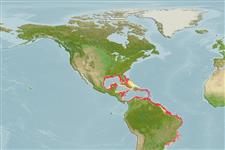Environment: milieu / climate zone / depth range / distribution range
Ecologie
marien demersaal; diepte 20 - 150 m (Ref. 5217). Subtropical; 30°N - 26°S, 98°W - 34°W
Western Atlantic: northwestern Gulf of Mexico to Brazil.
Grootte / Gewicht / Leeftijd
Maturity: Lm ? range ? - ? cm
Max length : 32.0 cm TL mannelijk / geslacht onbekend; (Ref. 5217); common length : 25.0 cm TL mannelijk / geslacht onbekend; (Ref. 3275); max. gepubliceerd gewicht: 371.30 g (Ref. 128822)
Dorsale stekels (totaal): 0; Dorsale zachte stralen (totaal): 82-90; Anale stekels 0; Anale zachte stralen: 63 - 69. Body is oval, moderately elongate. Dorsal fin originates distinctly anterior to a vertical at front of the eyes. Eyes on left side, not large, their diameter is 5 - 5.9 times the head length. The interorbital space is narrow, less than half the eye diameter. Lateral line on eyed side is not steeply arched above pectoral fin. The mouth is large extending slightly beyond the posterior margin of the eyes. Caudal fin is rounded. Color is brown with a large blotch beneath pectoral fin. The dorsal and anal fins have a row of dark spots containing pale areas,. Two spots on the dorsal and a few on the anal are large. The caudal fin has three large dark spots at the posterior border, none on center of the fin. Number of ovaries: 2. Ovaries are symmetrical, lie parallel with each other, depressed cross-sectionally and extra-visceral in location (Ref. 101557).
Occurs in bays, lagoons and shallow coastal waters. Found on soft bottoms (Ref. 5217). Marketed fresh (Ref. 5217).
Levenscyclus en paargedrag
Maturiteit | Voortplanting | Paaien | Eieren | Fecunditeit | Larven
Distinct pairing (Ref. 205). Number of ovaries: 2. Ovaries are symmetrical, lie parallel with each other, depressed cross-sectionally and extra-visceral in location (Ref. 101557).
Robins, C.R. and G.C. Ray, 1986. A field guide to Atlantic coast fishes of North America. Houghton Mifflin Company, Boston, U.S.A. 354 p. (Ref. 7251)
Status op de Rode Lijst van het IUCN (Ref. 130435)
Gevaar voor de mens
Harmless
Gebruik door de mens
Visserij: van minder commercieel belang
Meer informatie
ReferentiesAquacultuurAquacultuurprofielKweeklijnenGeneticaElectrophoresesErfelijkheidZiektesVerwerkingNutrientsMassaconversie
Tools
Speciale rapporten
Download XML
Internetbronnen
Estimates based on models
Preferred temperature (Ref.
123201): 19.6 - 27.4, mean 24.8 °C (based on 192 cells).
Fylogenetische diversiteitsindex (Ref.
82804): PD
50 = 0.5625 [Uniqueness, from 0.5 = low to 2.0 = high].
Bayesian length-weight: a=0.00891 (0.00405 - 0.01963), b=3.11 (2.93 - 3.29), in cm total length, based on LWR estimates for this (Sub)family-body shape (Ref.
93245).
Trofisch niveau (Ref.
69278): 3.6 ±0.2 se; based on size and trophs of closest relatives
Generation time: 1.4 ( na - na) years. Estimated as median ln(3)/K based on 1
growth studies.
Weerstandsvermogen (Ref.
120179): Hoog, minimale populatieverdubbelingstijd minder dan 15 maanden (K=0.78).
Fishing Vulnerability (Ref.
59153): Low vulnerability (20 of 100).
